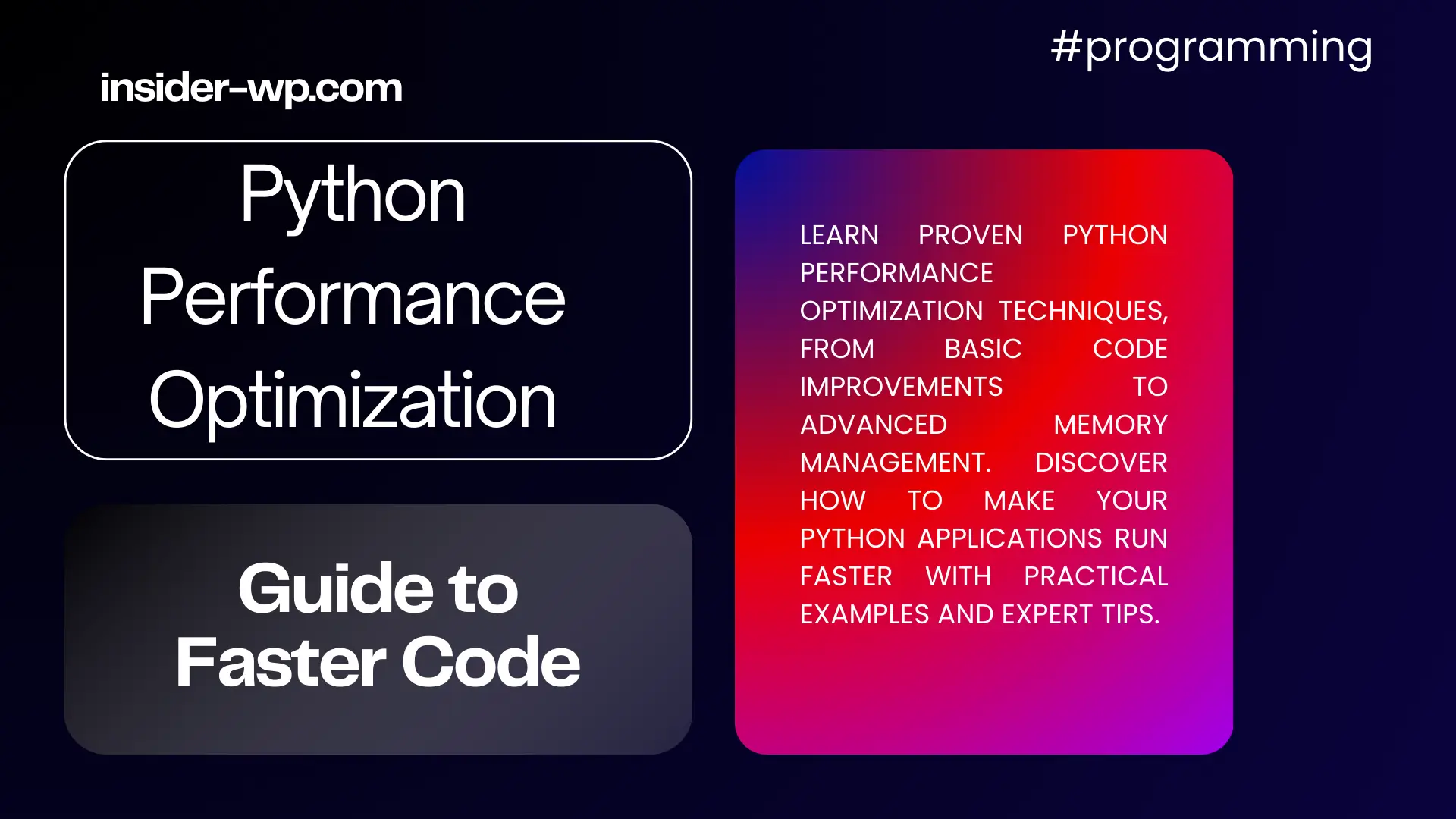Upselling: Boost Revenue & Enhance Client Satisfaction
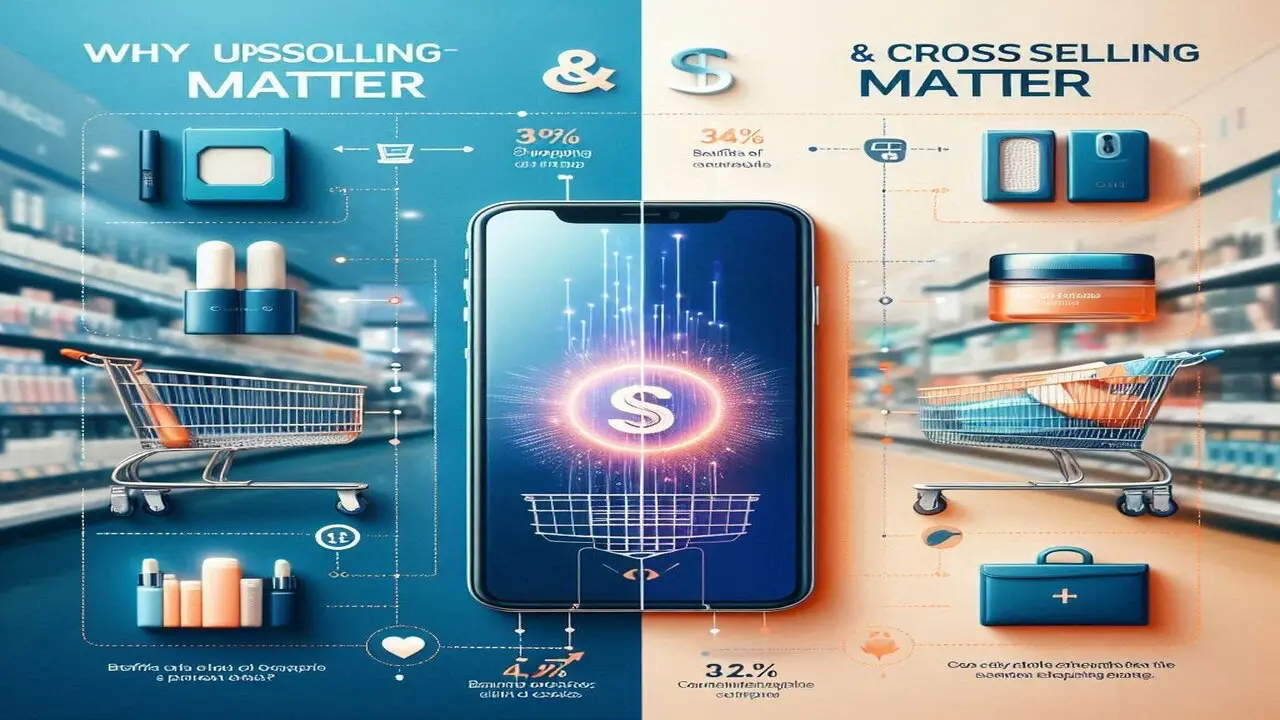
Upselling and cross-selling are two powerful sales techniques that can significantly boost revenue and customer lifetime value. While they may sound similar, there are distinct differences between the two strategies.
Upselling is the practice of encouraging customers to purchase a more expensive, premium, or upgraded version of the product or service they are already considering. The goal is to increase the transaction value by offering a better, more feature-rich option that provides additional benefits to the customer.

For example, when buying a laptop, an upsell would be the salesperson suggesting a model with a faster processor, more RAM, or a larger hard drive instead of the base model the customer initially wanted.
On the other hand, cross-selling involves offering complementary or related products and services to an existing customer. The aim is to generate additional revenue by bundling or combining products that enhance the customer’s overall experience or solve a broader set of their needs.
A classic cross-selling example is when a fast-food employee asks, “Would you like fries with that?” or when a retailer of electronics suggests adding an extended support plan, accessories, or warranty to a new device purchase.
While upselling focuses on increasing the value of the primary purchase, cross-selling expands the customer’s basket by adding supplementary items.
| Upselling | Cross-Selling |
| Encourages consumers to purchase a more costly or high-end version of the desired product | Offers complementary or related products in addition to the primary purchase |
| Example: Upgrading to a bigger smartphone storage capacity | Example: Adding a phone case and screen protector to a smartphone purchase |
| Increases the transaction value/average order size | Increases the number of products/services sold |
| Focuses on a single, enhanced product | Involves selling multiple, related products |
Both upselling and cross-selling aim to boost revenue and customer satisfaction, but they achieve these goals through different approaches. Upselling maximizes the value of each sale, while cross-selling expands the customer’s overall purchase.
Effective businesses often employ a combination of these techniques to capitalize on every sales opportunity and meet the diverse needs of their customers.
Why Upselling & Cross-Selling Matter?

In today’s fiercely competitive business landscape, upselling and cross-selling have become increasingly crucial for driving growth, maximizing profitability, and fostering long-term customer relationships. As we approach 2024, these sales strategies will continue to play a pivotal role in achieving success. Here’s why upselling and cross-selling matter:
Benefits of Upselling
- Increased Revenue: Upselling allows businesses to generate higher revenue from each customer transaction by encouraging the purchase of premium or upgraded products/services. According to a study by Forrester Research, upselling can boost revenue by 10-30%.
- Higher Average Order Value (AOV): By persuading customers to opt for more expensive or feature-rich offerings, upselling directly increases the average order value, leading to improved profit margins.
- Improved Customer Retention: When businesses provide customers with enhanced products or services that better meet their needs, it fosters greater satisfaction and loyalty, reducing churn and increasing customer lifetime value (CLV).
Benefits of Cross-Selling
- Complementary Sales: Cross-selling enables businesses to sell additional, related products or services that complement the primary purchase, unlocking new revenue streams and maximizing customer value.
- Enhanced Customer Satisfaction: By offering relevant, value-adding solutions that address a broader range of customer needs, cross-selling improves the overall customer experience and satisfaction levels.
- Increased Basket Size: Successful cross-selling campaigns can significantly increase the number of items in a customer’s shopping cart or basket, leading to higher transaction values and revenue.
| Upselling Benefits | Cross-Selling Benefits | Statistical Impact |
| Increased Revenue (10-30% boost according to Forrester Research) | Complementary Sales | 20-30% more revenue for companies excelling in these strategies (Salesforce) |
| Higher AOV | Enhanced Customer Satisfaction | 70% of Amazon’s revenue from these efforts (Marketing Metrics) |
| Improved Customer Retention | Increased Basket Size | 30% higher CLV for customers engaging in cross-selling (Bain & Company) |
Statistical Impact
The impact of effective upselling and cross-selling strategies is substantial, as evidenced by these statistics:
- Companies that excel at upselling and cross-selling generate 20-30% more revenue than those that don’t (Salesforce).
- 70% of Amazon’s revenue comes from cross-selling and upselling efforts (Marketing Metrics).
- Customers who engage in cross-selling tend to have a 30% higher lifetime value compared to those who don’t (Bain & Company).
Case Study Highlight
One notable case study comes from Sephora, the global beauty retailer. By implementing an effective cross-selling strategy, Sephora saw a 20% increase in their average order value and a 50% boost in the number of items per transaction.
As these benefits and statistics illustrate, leveraging upselling and cross-selling will be crucial for businesses in 2024 and beyond, enabling them to maximize revenue, foster customer loyalty, and drive sustainable growth.
5 Powerful Upselling Techniques for Success

Mastering the art of upselling requires a strategic approach that focuses on delivering value to customers while boosting your bottom line. Here are five powerful upselling techniques that will set you up for success in 2024 and beyond:
Understanding Customer Needs & Providing Value
The foundation of effective upselling lies in truly understanding your customers’ needs, preferences, and pain points. By actively listening and asking the right questions, you can identify opportunities to recommend premium products or services that directly address their specific requirements.
For example, if a customer is purchasing a basic fitness tracker, you could upsell them to a more advanced model with additional features like heart rate monitoring or GPS tracking based on their fitness goals and lifestyle.
The key is to position the upsell as a valuable solution that enhances their experience or solves a problem they may not have initially considered.
Building Trust & Developing Rapport
Customers are more receptive to upselling when they trust and have a positive rapport with the salesperson or brand. Building this trust requires transparency, honesty, and a genuine commitment to serving the customer’s best interests.
Share relevant knowledge, provide helpful advice, and demonstrate expertise in your product line. This approach positions you as a trusted advisor rather than a pushy salesperson, making customers more likely to value and consider your upsell recommendations.
Focusing on Benefits Over Features
Instead of rattling off a list of technical specifications or features, successful upselling focuses on clearly communicating the tangible benefits and real-world value the premium product or service offers.
For instance, rather than emphasizing the higher megapixel count of a camera upgrade, highlight how it will enable the customer to capture stunning, high-quality images that they’ll cherish for years to come.
By painting a vivid picture of how the upsell will positively impact their lives, you make it easier for customers to justify the additional investment.
Not Overselling & Pivoting Strategies
While upselling is essential, it’s crucial to avoid being overly aggressive or pushy, as this can quickly alienate customers and damage trust. If a customer declines an upsell offer, gracefully accept their decision and move on.
Moreover, be prepared to pivot your upselling strategy based on the customer’s responses and body language. If a particular approach isn’t resonating, shift gears and try a different angle or technique.
Flexibility and adaptability are key to successful upselling.
Combining With Other Tactics (Email, PPC, Social Proof)
Upselling doesn’t have to be limited to face-to-face interactions. Incorporate upselling into your broader marketing and sales strategies by leveraging tactics like:
- Email Marketing: Use personalized email campaigns to promote premium products or limited-time offers to existing customers.
- Pay-Per-Click (PPC) Advertising: Highlight premium product options and their benefits through targeted PPC ads on search engines and social media platforms.
- Social Proof: Include customer reviews, testimonials, and social media posts that showcase the advantages of your premium offerings.
| Technique | Key Points |
| Understanding Customer Needs & Providing Value | – Listen and understand customer needs – Recommend products that address specific requirements – Position upsell as a valuable solution |
| Building Trust & Developing Rapport | – Be transparent and honest – Share knowledge and advice – Position yourself as a trusted advisor |
| Focusing on Benefits Over Features | – Communicate tangible benefits – Highlight real-world value and impact |
| Not Overselling & Pivoting Strategies | – Avoid being pushy – Be adaptable and change in response to client input. |
| Combining With Other Tactics (Email, PPC, Social Proof) | – Use personalized email campaigns – Targeted PPC ads – Showcase advantages through customer reviews and social media |
By combining upselling with these complementary tactics, you create a cohesive, multi-channel approach that increases your chances of success.
Implementing these five powerful upselling techniques will help you maximize revenue, enhance customer satisfaction, and drive long-term business growth in 2024 and beyond.
Real Examples of Impressive Upselling Campaigns
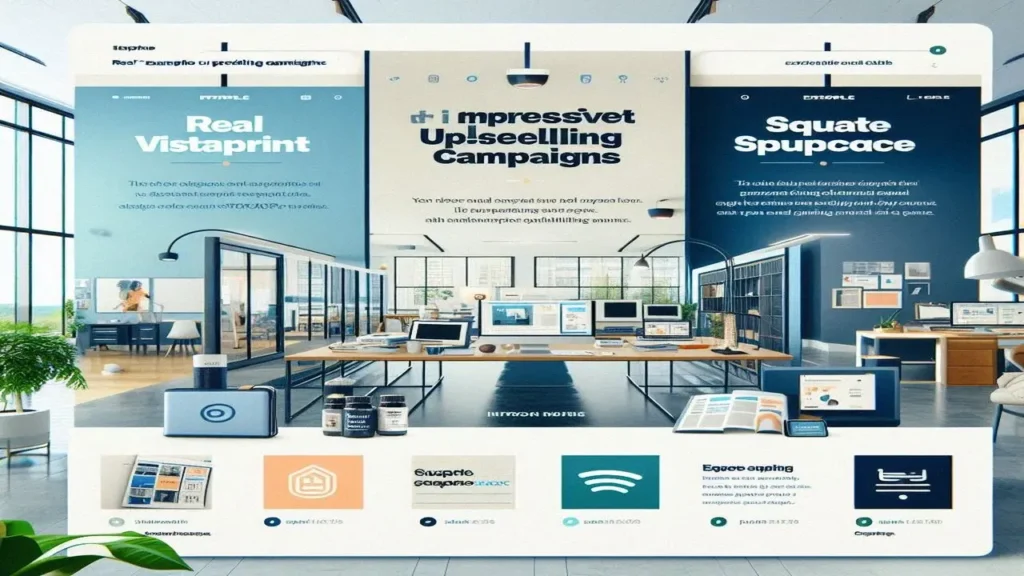
Companies across various industries have successfully implemented upselling strategies to drive significant revenue growth and enhance customer experiences. Here are a few real-world examples of impressive upselling campaigns:
Vistaprint
Vistaprint, a leading online printing service, has mastered the art of upselling. When customers design and order business cards, they are presented with intelligent upsell opportunities throughout the process. These include:
- Upgrading to premium paper stock or finishes like glossy or matte lamination
- Adding complementary products like matching letterheads, envelopes, or promotional items
- Bundling services like design assistance or expedited shipping
By offering these relevant upsells seamlessly integrated into the customer journey, Vistaprint increases average order values and provides a more comprehensive solution tailored to each customer’s needs.
Squarespace
Squarespace, a popular website-building platform, exemplifies effective upselling tactics. As users progress through the website creation process, they encounter strategic upsell opportunities, such as:
- Upgrading from a personal plan to a business or commerce plan for advanced features
- Adding a professional email account or Google Workspace integration
- Purchasing premium templates, stock images, or design services
These upsells not only enhance the user’s website capabilities but also position Squarespace as a one-stop-shop for all their online presence needs, fostering long-term customer relationships.
Spotify
The music streaming giant Spotify has found success in upselling its premium subscription plans. While users can access Spotify for free with advertisements, the platform strategically highlights the benefits of upgrading to its ad-free Premium or Premium Duo/Family plans through:
- Targeted in-app messaging and pop-ups
- Limited free trial periods for premium features
- Bundling premium plans with partner offerings (e.g., Hulu or Showtime subscriptions)
By consistently showcasing the advantages of its premium tiers, such as ad-free listening, offline mode, and higher audio quality, Spotify effectively converts free users into paid subscribers, increasing customer lifetime value.
These examples demonstrate how companies across different sectors leverage upselling to not only drive revenue growth but also to provide customers with enhanced experiences and greater value. By aligning upsell offers with customer needs and preferences, businesses can foster long-lasting relationships and sustainable success.
Mastering the Art of Cross-Selling
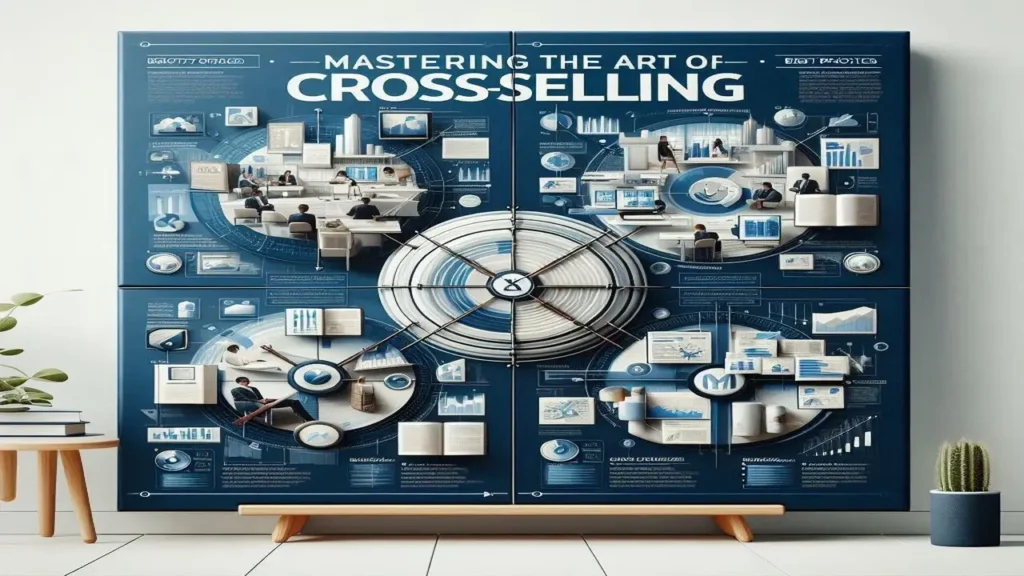
Cross-selling is an art that requires a deep understanding of customer needs, preferences, and buying behaviors. When executed effectively, it can significantly enhance the customer experience, boost revenue, and foster long-lasting relationships. Here are some key strategies for mastering the art of cross-selling:
Identifying Relevant Complementary Products
The foundation of successful cross-selling lies in offering products or services that genuinely complement the customer’s primary purchase. This requires a thorough knowledge of your product catalog and how different items can be bundled or combined to provide a complete solution.
For example, if a customer is purchasing a digital camera, relevant cross-sell options could include:
- Camera bag or case
- Additional lenses
- Tripod
- External flash
- Editing software
- Memory cards
By offering these complementary products, you not only increase the transaction value but also enhance the customer’s overall experience with their primary purchase.
Offering at the Right Times
Timing is crucial when it comes to cross-selling. There are three key opportunities to present cross-sell offers:
- Before the Purchase: During the research and consideration phase, you can suggest complementary products that may address additional needs or use cases the customer hasn’t considered.
- During the Purchase: At the point of sale or checkout, cross-selling can be highly effective. Customers are already in a buying mindset, making them more receptive to complementary offers.
- After the Purchase: Post-purchase cross-selling can be a powerful way to capitalize on customer satisfaction and reinforce the value of your products or services. Follow-up emails, thank-you pages, or personalized recommendations can present relevant cross-sell opportunities.
Leveraging Customer Data for Personalized Recommendations
In today’s data-driven world, personalization is key to successful cross-selling. By leveraging customer data, such as purchase history, browsing behavior, and demographic information, you can make highly relevant and targeted cross-sell recommendations.
For example, if a customer frequently purchases outdoor gear, cross-selling camping equipment or hiking accessories would be a natural fit. Or, if a customer has purchased baby products, cross-selling toys or children’s books could be a valuable suggestion.
Customer Relationship Management (CRM) systems and analytics tools can help you analyze customer data and identify cross-selling opportunities tailored to individual preferences and needs.
Best Practices for Effective Cross-Selling Pitches
When presenting cross-sell offers, it’s essential to approach it from a consultative, customer-centric perspective. Here are some best practices:
- Focus on the Benefits: Instead of simply listing product features, highlight how the cross-sell items will enhance the customer’s experience or solve a specific problem they may have.
- Use Persuasive Language: Craft compelling cross-sell pitches that speak to the customer’s needs and desires. Use action-oriented language and address potential objections or concerns.
- Provide Context: Explain how the cross-sell products relate to and complement the primary purchase. This helps the customer understand the value proposition.
- Offer Bundled Discounts: Bundling cross-sell items at a discounted price can be an attractive incentive for customers to maximize their purchase.
- Train Your Team: Ensure your sales team is well-versed in cross-selling techniques, product knowledge, and customer service skills to deliver a seamless cross-selling experience.
By following these strategies and best practices, you can effectively cross-sell, increase revenue, and create a more satisfying and valuable experience for your customers.
How to Identify Prime Upselling & Cross-Selling Opportunities

Maximizing upsell and cross-sell success relies heavily on identifying the right opportunities throughout the customer journey. Here are some key points when these opportunities arise:
Before the Sale
Even before a customer commits to a purchase, there are chances to upsell or cross-sell. These include:
- On product pages: Showcase premium versions, related add-ons, or complementary items.
- During consultations: Understand customer needs and pain points to recommend appropriate upsell/cross-sell options.
- In marketing materials: Email campaigns, ads, and content can highlight upgraded offerings or bundle deals.
At Checkout
The checkout process is a prime opportunity to increase order value through upselling and cross-selling tactics such as:
- Order bumps: Offering add-ons like extended warranties, subscriptions, or premium support.
- Product bundles: Presenting cost-saving combo deals on related products/services.
- Size/Quantity Upgrades: Suggesting larger sizes, bulk purchases, or annual plans.
After Purchase
The opportunities don’t end after a sale is made. Businesses can continue upselling and cross-selling by:
- Following up with complementary product recommendations based on the initial purchase.
- Offering subscription renewals or upgrades for continued service.
- Suggesting accessories, consumables, or spare parts for the purchased product.
- Presenting limited-time deals on premium tiers or additional services.
Analyzing Customer Data
With access to robust customer data and insights, businesses can identify highly targeted upsell and cross-sell opportunities by:
- Tracking purchase history and browsing behavior to understand interests.
- Segmenting customers based on demographics, lifecycle stage, or spending patterns.
- Monitoring feedback, reviews, and support queries to pinpoint unmet needs.
- Leveraging predictive analytics to forecast future purchases and make timely recommendations.
By seizing opportunities at different touchpoints and tapping into data-driven insights, businesses can strategically present relevant upsell and cross-sell offers that delight customers and boost revenue.
Strategies to Maximize Upselling & Cross-Selling Results

To maximize the impact of upselling and cross-selling initiatives, businesses should employ a well-rounded approach that leverages various strategies throughout the customer journey. Here are four important strategies to consider:
Product Upgrades & Premium Versions
One of the most effective upselling tactics is to offer product upgrades or premium versions. This involves presenting customers with higher-end, feature-rich alternatives to the products they are considering.
For example, a software company could upsell customers from a basic plan to a pro or enterprise plan with advanced features, increased storage, or priority support. Similarly, a clothing retailer might encourage customers to choose a higher-quality fabric or limited-edition variant of the item they initially selected.
These upgrades typically command a higher price point, leading to increased transaction values and profit margins. However, it’s crucial to communicate the additional benefits clearly and position the premium option as a valuable investment for the customer.
Bundling Products & Services
Product bundling is a powerful cross-selling strategy that involves packaging complementary products or services together as a single offering. This approach not only increases the overall transaction value but also provides added convenience and perceived value for customers.
For instance, an electronics retailer could bundle a new television with a soundbar, wall mount, and HDMI cables as a comprehensive home entertainment package. Similarly, a travel agency might cross-sell flight tickets, hotel accommodations, and rental car services as a bundled vacation package.
Bundling allows businesses to streamline the sales process, simplify the purchasing decision for customers, and potentially offer discounts on the combined offering, making it an attractive proposition.
Post-Purchase Upsells & Cross-Sells
While many upselling and cross-selling opportunities arise during the initial sales process, businesses should also leverage post-purchase touchpoints to maximize revenue potential.
For example, after a customer purchases a new smartphone, the retailer could follow up with offers for cases, screen protectors, extended warranties, or accessories like wireless charging pads or headphones.
Similarly, after a customer books a hotel stay, the hotel could upsell or cross-sell additional amenities like room upgrades, spa packages, or dining experiences.
Post-purchase upsells and cross-sells capitalize on the positive sentiment and existing relationship with the customer, making them more receptive to additional offers that enhance their overall experience.
Leveraging Tools & Technology
In today’s digital age, businesses can leverage a range of tools and technologies to streamline and optimize their upselling and cross-selling efforts.
- Upsell & Cross-Sell Software: Specialized software platforms and plugins can analyze customer data, track purchase patterns, and deliver personalized upsell and cross-sell recommendations in real-time, both on product pages and during the checkout process.
- Automation & Personalization: By integrating with customer data platforms and customer relationship management (CRM) systems, businesses can automate personalized upsell and cross-sell campaigns across various channels, such as email, SMS, and in-app notifications.
- A/B Testing & Analytics: Robust analytics tools and A/B testing capabilities enable businesses to continuously refine and optimize their upselling and cross-selling strategies, identifying the most effective approaches and offers for different customer segments.
By leveraging the right tools and technologies, businesses can streamline their processes, enhance the customer experience, and maximize the impact of their upselling and cross-selling initiatives.
These four strategies – offering product upgrades, bundling complementary offerings, capitalizing on post-purchase opportunities, and utilizing cutting-edge tools – can significantly boost sales, revenue, and customer lifetime value when implemented effectively.
Creating a Suggestive Selling Experience

Successful upselling and cross-selling go beyond merely offering additional products or upgrades. To truly maximize these strategies, businesses must create a compelling suggestive selling experience that resonates with customers on a deeper level. This involves:
Understanding Preferences & Buying Behaviors
The key to effective suggestive selling lies in truly understanding your customers’ preferences, pain points, and buying behaviors. By leveraging data insights, purchase histories, and customer feedback, you can gain a comprehensive view of what motivates your audience and what they value most.
For instance, if your analytics reveal that a significant portion of customers who purchase product A also tend to buy product B within a specific timeframe, you can use that knowledge to create targeted cross-selling campaigns.
Providing Relevant Personalized Recommendations
Armed with a deep understanding of your customers, you can then provide highly relevant and personalized upsell and cross-sell recommendations tailored to their specific needs and interests.
Personalization is crucial in today’s crowded marketplace, as customers are bombarded with generic sales pitches. By offering recommendations that directly address their unique circumstances, you demonstrate a genuine commitment to their satisfaction, fostering trust and loyalty.
Personalization is no longer a luxury for organizations that want to stay consumer-focused and experience-driven. It’s a make-or-break imperative.
Using Persuasive Upsell/Cross-Sell Scripts & Phrases
While data and personalization are powerful tools, the art of suggestive selling also relies on using the right language and persuasive techniques. Crafting compelling upsell and cross-sell scripts can significantly influence a customer’s purchasing decisions.
Effective scripts should:
- Highlight the benefits and value propositions of the recommended products or upgrades.
- Use positive language that resonates with the customer’s desires and pain points.
- Employ persuasive phrases like “You might also enjoy…” or “Many customers in your situation have found value in…”
Example: Based on your interest in [current product], I think you’d really appreciate the enhanced features and performance of our [premium product]. Customers like yourself have found that the additional [key benefit] has made a significant difference in [addressing their pain point].
Building Customer Trust & Rapport
Ultimately, suggestive selling success hinges on building strong customer trust and rapport. Customers are more likely to respond positively to upsell and cross-sell offers when they perceive the recommendations as genuine attempts to enhance their experience rather than pushy sales tactics.
To build trust, sales teams should:
- Prioritize the customer’s needs over making a sale.
- Provide transparent and honest information about product offerings.
- Demonstrate expertise and a deep understanding of the products and the customer’s unique situation.
- Maintain a consultative, non-pushy approach focused on adding value.
By creating a suggestive selling experience that combines data-driven insights, personalization, persuasive language, and genuine customer rapport, businesses can significantly enhance the effectiveness of their upselling and cross-selling efforts, leading to increased revenue, customer satisfaction, and long-term loyalty.
Best Practices for Effective Upselling & Cross-Selling
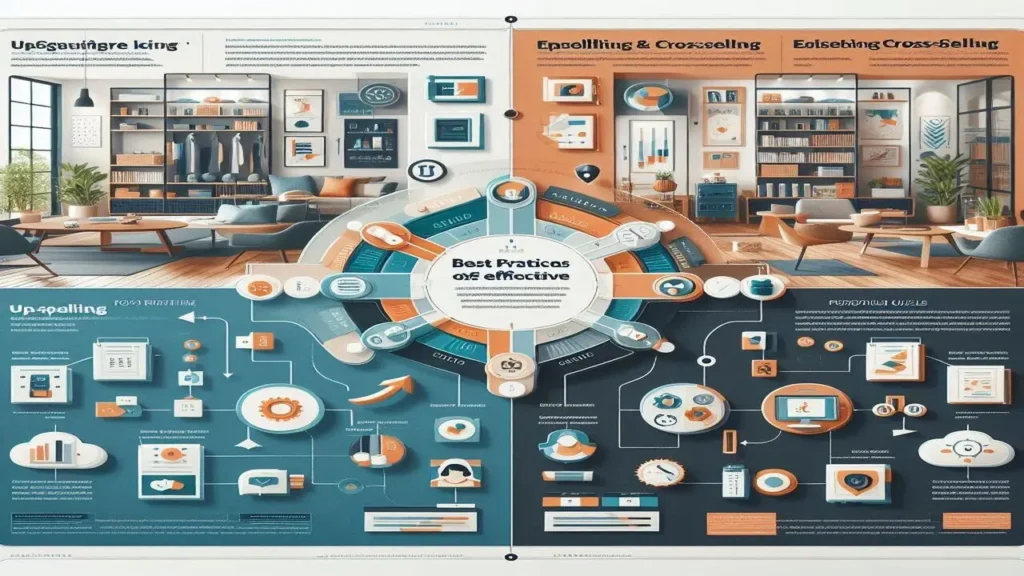
While upselling and cross-selling can significantly boost sales and revenue, it’s crucial to implement these strategies tactfully and prioritize the customer’s needs. Here are some best practices to follow for effective upselling and cross-selling:
Prioritize Customer Needs & Add Value
The key to successful upselling and cross-selling is to truly understand your customers’ needs, preferences, and pain points. Never try to force a sale or push products they don’t need. Instead, focus on offering solutions that genuinely enhance their experience or solve a specific problem they’re facing.
For example, if a customer is purchasing a high-end camera, cross-selling a durable camera bag or recommending a lens upgrade based on their photography interests adds tangible value to their purchase.
Maintain Reasonable Pricing & Relevant Offers
While upselling and cross-selling aim to increase revenue, it’s important to keep pricing reasonable and ensure the offers are relevant to the customer’s initial purchase. Suggesting excessively expensive upgrades or unrelated products can come across as pushy and damage customer trust.
Follow the principle of offering incremental value at a fair price. For instance, if a customer is buying a basic software package, upselling to the next tier with additional features they might find useful is a reasonable offer.
Avoid Overwhelming with Too Many Options
Bombarding customers with an overwhelming number of upsell and cross-sell options can lead to decision paralysis and frustration. Keep the offers focused and streamlined, presenting only the most relevant and valuable options.
Consider using a tiered approach, where you first suggest the primary upsell or cross-sell, and if the customer declines, offer a secondary option. Presenting too many choices simultaneously can be confusing and counterproductive.
Use a Consultative, Non-Pushy Approach
Effective upselling and cross-selling should be a consultative process, not a high-pressure sales pitch. Adopt a friendly, helpful tone, and position yourself as an advisor rather than a salesperson.
Listen to the customer’s needs, ask thoughtful questions, and provide knowledgeable recommendations based on their specific circumstances. Avoid using pushy or aggressive tactics, as this can damage customer trust and potentially lead to lost sales.
The key to successful upselling and cross-selling is to truly listen to your customers and offer solutions that add genuine value to their lives. – Neil Patel, Co-Founder of Neil Patel Digital
By following these best practices, businesses can effectively upsell and cross-sell while maintaining a positive customer experience and fostering long-term loyalty.
Upselling & Cross-Selling for E-Commerce
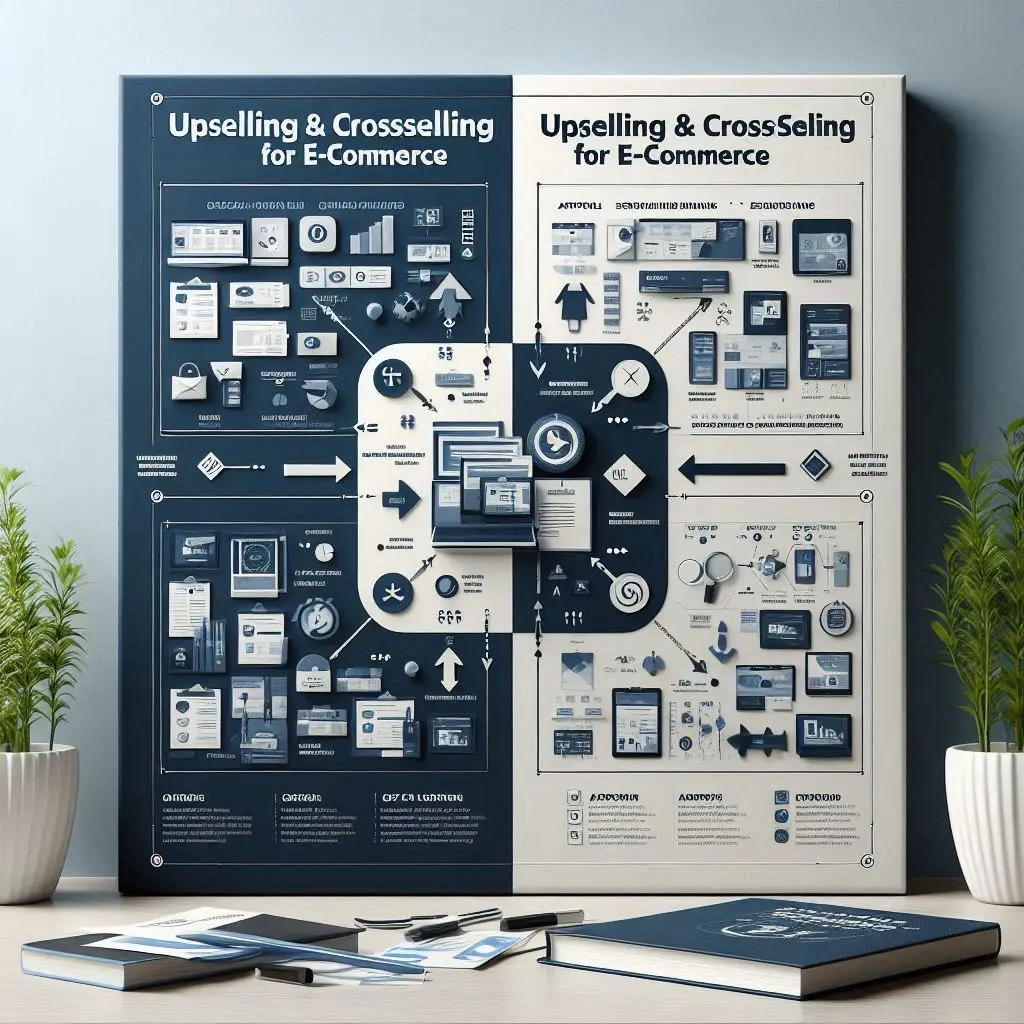
In the e-commerce world, upselling and cross-selling techniques are crucial for maximizing revenue and customer lifetime value. With the right strategies, online businesses can offer a seamless and personalized shopping experience while boosting average order values and customer satisfaction. Here are some effective approaches for implementing upselling and cross-selling tactics in e-commerce:
On Product/Checkout Pages
Product and checkout pages are prime real estate for upselling and cross-selling opportunities. E-commerce platforms can display personalized recommendations for upgraded versions, bundles, or complementary products based on the customer’s current selection and past purchase behavior.
For example, Amazon prominently showcases “Frequently bought together” and “Customers who bought this item also bought” sections, encouraging customers to add related items to their cart.
Strategic Pop-ups & Overlays
Well-timed and relevant pop-ups or overlay windows can be effective for presenting upsell and cross-sell offers during the checkout process. These can highlight premium product options, bundles, or complementary items that customers may have overlooked.
However, it’s crucial to strike a balance and avoid overwhelming customers with too many pop-ups, which can lead to frustration and abandonment.
Abandoned Cart Tactics
Cart abandonment is a significant challenge for e-commerce businesses, but it also presents an opportunity for upselling and cross-selling. By tracking abandoned carts and sending targeted email or push notifications, companies can remind customers of their intended purchases while suggesting relevant upgrades or complementary products.
For instance, a clothing retailer could send an abandoned cart email offering a discount on the items in the cart or recommending a matching accessory or outfit bundle.
A/B Testing Different Methods
Continuously optimizing upselling and cross-selling strategies is essential for maximizing their effectiveness. A/B testing different approaches, such as the placement, messaging, and timing of offers, can help e-commerce businesses identify the most compelling and successful tactics for their target audience.
Testing variables like product recommendations, call-to-action buttons, and offer framing can provide valuable insights into what resonates best with customers and drives higher conversion rates.
By leveraging these e-commerce-specific upselling and cross-selling tactics, online businesses can enhance the customer experience, increase average order values, and foster long-term customer loyalty.
Leveraging Tools & Integrations

In today’s competitive marketplace, leveraging the right tools and integrations can give businesses a significant advantage when it comes to executing effective upselling and cross-selling strategies. Here are some key tools and integrations to consider:
Upselling & Cross-Selling Software
Dedicated upsell and cross-sell software solutions are designed to streamline and automate these processes. These platforms typically offer features like:
- Product recommendation engines: Suggest relevant upsell and cross-sell opportunities based on customer data, purchase history, and browsing behavior.
- Dynamic merchandising: Dynamically display personalized upsell and cross-sell offers on websites, emails, and other touchpoints.
- A/B testing and analytics: Test and optimize different upsell/cross-sell offers, and track performance metrics.
- Integration with ecommerce platforms: Seamlessly integrate with popular ecommerce platforms like Shopify, Magento, and WooCommerce.
Popular upsell and cross-sell software solutions include Nosto and PriceYak.
Automation with Personalization
One key aspect of successful upselling and cross-selling is personalization. By leveraging automation tools, businesses can deliver highly personalized and contextual offers based on customer data and behaviors.
For example, an online retailer could use a tool like Unbxd or Clerro to automatically recommend relevant products, upgrades, and bundles based on a customer’s browsing history, preferences, and purchase patterns.
Customer Data Platforms & Insights
Effective upselling and cross-selling strategies rely heavily on understanding customer needs, behaviors, and purchasing patterns. Customer Data Platforms (CDPs) can provide valuable insights to inform these strategies.
Popular CDP solutions like Segment and BlueConic allow businesses to collect, organize, and analyze customer data from multiple sources. This data can then be used to personalize upsell and cross-sell offers, identify prime opportunities, and create targeted campaigns.
Additionally, many CDP platforms offer integration with marketing automation tools, ecommerce platforms, and business intelligence solutions for a seamless, data-driven approach to upselling and cross-selling.
By leveraging the right tools and integrations, businesses can streamline and optimize their upselling and cross-selling efforts, delivering personalized and compelling offers to customers at the right times and touchpoints. This data-driven approach leads to increased conversions, higher revenue, and better customer experiences.
Metrics to Measure & Optimize Upselling & Cross-Selling Performance

To ensure the long-term success of your upselling and cross-selling efforts, it’s crucial to consistently measure and optimize your performance. By tracking the right metrics, conducting A/B tests, and making data-driven decisions, you can continually refine your strategies and maximize results.
Key Upselling & Cross-Selling Metrics to Track
- Upsell Rate: The percentage of customers who accept an upsell offer. This metric helps you gauge the effectiveness of your upselling techniques.
- Cross-Sell Rate: The percentage of customers who purchase additional products or services through cross-selling.
- Average Order Value (AOV): The average revenue generated per transaction. Successful upselling and cross-selling should increase your AOV over time.
- Revenue from Upsells/Cross-Sells: The total revenue generated specifically from upsell and cross-sell initiatives. This metric directly shows the impact on your bottom line.
- Customer Lifetime Value (CLV): The total revenue a customer generates throughout their relationship with your business. Upselling and cross-selling can significantly boost CLV.
- Conversion Rates: Track conversion rates at various stages of the sales funnel to identify opportunities for optimization.
- Customer Satisfaction: Monitor customer feedback, reviews, and Net Promoter Scores (NPS) to ensure your upsell and cross-sell tactics align with delivering an exceptional customer experience.
A/B Testing Optimization
A/B testing, also known as split testing, is a powerful technique for optimizing your upselling and cross-selling strategies. By creating variations of your offers, messaging, or presentation methods, and presenting them to different customer segments, you can identify which approaches resonate best.
Some elements to consider A/B testing include:
- Upsell/cross-sell offer wording and positioning
- Visual elements like product images and layouts
- Timing and placement of offers (e.g., during checkout, post-purchase)
- Incentives or discounts offered
Continuously A/B test different variations and analyze the performance data to make informed decisions about which approaches to scale or refine.
Data-Driven Continuous Improvement
Upselling and cross-selling are not one-size-fits-all strategies. Your tactics should evolve based on changing customer preferences, market trends, and performance insights. Regularly review your metrics, customer feedback, and sales data to identify areas for improvement.
Leverage tools like customer relationship management (CRM) systems, analytics platforms, and heat mapping software to gain a deeper understanding of customer behavior and preferences. Use these insights to refine your product recommendations, messaging, and offers for maximum relevance and impact.
Additionally, stay up-to-date with industry best practices, case studies, and emerging technologies that could enhance your upselling and cross-selling capabilities.
Continuous optimization based on data-driven insights is key to ensuring your upselling and cross-selling efforts remain effective, efficient, and aligned with delivering an exceptional customer experience.
By consistently measuring performance, conducting A/B tests, and making data-driven improvements, you can fine-tune your upselling and cross-selling strategies for sustainable success and growth.
The Role in Driving Long-Term Customer Value and Loyalty

Implementing strategic upselling and cross-selling goes beyond short-term revenue gains. When done right, these techniques can significantly enhance customer lifetime value (CLV) and foster long-lasting loyalty.
By consistently offering relevant product or service upgrades and complementary solutions, you demonstrate a deep understanding of your customers’ evolving needs. This level of personalized attention and value-added service builds trust, strengthens relationships, and sets your business apart from competitors.
Ultimately, sustainable success in upselling and cross-selling hinges on striking the perfect balance between driving revenue growth and delivering an exceptional customer experience. Businesses that master this balance will not only maximize sales but also cultivate a loyal, advocate customer base that serves as a powerful driving force for long-term growth and profitability.
Final Tips for Smart Implementation

- Train and Incentivize Your Team: Ensure all customer-facing employees, from sales reps to support staff, understand the value of upselling and cross-selling and are trained in best practices. Consider incentivizing successful implementations.
- Start Small and Scale: Begin with a few proven upsell and cross-sell tactics, measure their performance, and gradually expand your efforts based on what works best for your business and customers.
- Maintain a Customer-Centric Approach: While upselling and cross-selling can boost revenue, never sacrifice customer satisfaction or trust. Always prioritize providing genuine value and solutions that enhance the customer experience.
- Stay Agile and Adapt: Consumer preferences, market trends, and technologies are constantly evolving. Regularly review and adjust your upselling and cross-selling strategies to stay relevant and effective.
Conclusion: Keys for Sustainable Upselling & Cross-Selling Success
Throughout this comprehensive guide, we’ve explored the powerful sales strategies of upselling and cross-selling, their differences, and how to leverage them effectively in 2024 and beyond. Let’s summarize the top strategies covered:
- Understand Customer Needs and Preferences: Successful upselling and cross-selling start with a deep understanding of your customers’ unique needs, pain points, and buying behaviors. Use data insights, past purchase history, and open communication to tailor your offers accordingly.
- Build Trust and Rapport: Customers are more likely to accept upsell and cross-sell recommendations from businesses they trust. Focus on delivering value, being transparent, and building strong relationships through exceptional customer service.
- Offer Relevant and Personalized Recommendations: Generic, one-size-fits-all upsell and cross-sell offers are rarely effective. Leverage customer data, purchase context, and personas to provide highly relevant and personalized product or service recommendations.
- Timing is Everything: Identify the optimal moments in the customer journey to present upsell and cross-sell opportunities. These could be before, during, or after the primary purchase, depending on your products and customer behavior.
- Utilize Persuasive Techniques: Highlight the benefits, not just features, of your upsell and cross-sell offerings. Create a sense of urgency, leverage social proof, and use compelling language and visuals to increase perceived value.
- Adopt an Omnichannel Approach: Seamlessly integrate upselling and cross-selling across all customer touchpoints, including e-commerce websites, mobile apps, physical stores, and post-purchase follow-ups.
- Leverage Technology and Automation: Implement upsell and cross-sell tools, software, and integrations to streamline processes, personalize recommendations, and automate workflows without losing the human touch.
- Continuously Measure and Optimize: Track key metrics, A/B test different approaches, and use data-driven insights to refine your upselling and cross-selling strategies continuously for maximum impact.
FAQs
What is upselling? What is cross-selling?
Upselling is the practice of encouraging customers to purchase a more expensive, premium, or upgraded version of the product or service they are already considering. For example, a car dealership upselling by recommending a higher-trim level or added features to a vehicle.
Cross-selling involves offering complementary or related products and services to an existing customer in addition to their primary purchase. A common example is an electronics store suggesting a warranty, accessories, or technical support along with a new laptop or TV.
How are upselling and cross-selling different?
The key difference lies in their goals and approach. Upselling aims to increase the transaction value by selling a more premium version of the same product, while cross-selling focuses on generating additional revenue by bundling complementary products or services.
Why are upselling and cross-selling important?
Both strategies are crucial for businesses as they:
- Increase revenue and average order value
- Boost customer lifetime value and retention
- Enhance customer satisfaction by meeting more needs
- Are more cost-effective than acquiring new customers
What are effective upselling techniques for 2024?
Some powerful upselling techniques for 2024 include:
- Understanding customer needs and providing personalized recommendations
- Building trust and rapport through consultative selling
- Focusing on benefits over features when presenting upgrade options
- Leveraging data and customer insights for targeted upsell offers
- Combining upselling with tactics like email marketing, social proof, and creating urgency
What are effective cross-selling techniques?
Effective cross-selling strategies involve:
- Identifying complementary products relevant to the customer’s purchase
- Offering cross-sells at strategic times (pre-sale, during checkout, post-purchase)
- Leveraging customer data and purchase history for personalized recommendations
- Training employees on consultative cross-selling techniques
- Implementing cross-sells through multiple touchpoints (online, in-store, email).
How to identify good upsell & cross-sell opportunities?
Key opportunities for upselling and cross-selling include:
- Before the sale (during product research or consultation)
- At checkout or point-of-sale
- After the purchase (order confirmations, thank you pages, follow-ups)
- Analyzing customer data (purchase history, browsing behavior, preferences).
What are upselling & cross-selling best practices?
Best practices include:
- Prioritizing customer needs and providing genuine value
- Maintaining reasonable pricing and relevant offers
- Not overwhelming customers with too many options
- Using a consultative, non-pushy approach
- Continuously optimizing based on data and customer feedback.
Common upselling & cross-selling mistakes?
Common pitfalls to avoid include:
- Irrelevant or poorly-timed upsell/cross-sell offers
- Aggressive or pushy sales tactics
- Lack of employee training on suggestive selling
- Neglecting the importance of downselling when appropriate
- Not measuring and optimizing performance based on data.
How to measure & optimize performance?
To measure and optimize upsell and cross-sell performance:
- Track key metrics like upsell/cross-sell rate, revenue contribution, customer acceptance
- Conduct A/B testing to compare different approaches
- Analyze customer data and feedback for continuous improvement
- Adjust strategies based on performance insights.
How to train employees for better suggestive selling?
Effective employee training should focus on:
- Understanding the value proposition of upsells and cross-sells
- Mastering consultative selling techniques and building rapport
- Identifying customer needs and providing relevant recommendations
- Overcoming objections and knowing when to downsel
- Continuous coaching and performance monitoring

